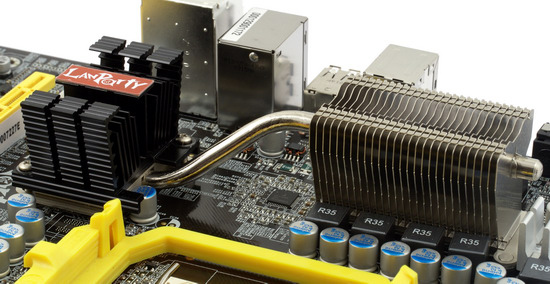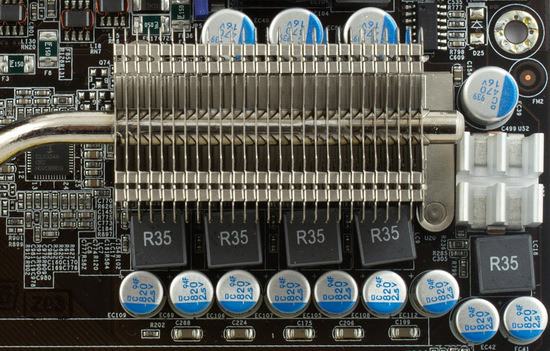Owing to the launch of the AMD 785G chipset, we've recently paid much attention to motherboards with integrated graphics. Some of them were quite feature-rich, full-size products suitable for budget configurations with one or two monitors, as well as powerful all-purpose rigs with discrete a graphics card or two. For example, ASUS M4A785TD-V EVO or Gigabyte MA785GT-UD3H.
However, you may get an impression that the AMD's modern platform is not the best choice for users in need of a classic discrete configuration. This is not true. On the contrary, since Phenom II Socket AM3 processors are compatible with both DDR2 and DDR3 memory, users have lots of options. Some of you may be confused by the fact that Northbridges in AMD 770, 790X and 790FX were designed almost two years ago. However, it doesn't mean they are outdated in terms of technical specifications. For example, all PCI Express lanes in these chipsets conform to the second version of the standard, while Intel and NVIDIA have even newer models support PCIE 2.0 only for graphics ports. This provides no bonuses (except for the undocumented CrossFire support on motherboards with AMD 770), of course. But it's a good example that these chipsets were designed for the future.
That's why we decided to review an ideologically different motherboard this time. Firstly, it supports DDR2. That is, it's designed for users willing to keep their high-capacity memory kits. As our tests have confirmed, DDR2-1066 is not much slower than DDR3-1333 in case of Phenom II 700/900 with large caches. Secondly, this motherboard has three PCI slots, is based on a discrete chipset, and has other signs of a product for conservative users of classic configurations. Finally, this one is a model from the well-known DFI which has finally made it to the Russian market.
Design
However, this motherboard has no "daring" solutions like remote chipset heatsinks or other DFI's experiments. It's a utilitarian and relatively inexpensive model. What concerns formal excesses, we can mention only a POST indicator, power and reset buttons on the board, five fan headers, and an additional power connector for graphics cards (for powerful solutions that don't have own power connectors to be plugged directly to a PSU). If you like experimenting with BIOS, you will like duplicated Clear CMOS jumpers: one is traditionally installed near the BIOS chip, while the other is on the rear panel.
We didn't like the lack of markings on memory slots (whether they belong to the first or the second channel). Moreover, the slots are numbered in a strange order: 1, 3, 2, 4. Alas, such labels are added only on rare motherboards. But in this case, even the guide makes no mention of this fact. Moreover, when BIOS initializes, it does not indicate directly whether two channels are used. Using the hit-and-miss method we found out that a couple of memory modules should be installed in the most popular way: in the neighboring slots starting from the CPU socket.
In our opinion, the cooling system has an optimal design for a motherboard for overclockers. Heatsinks on the Northbridge and MOSFETs in the voltage regulator are connected with a heat pipe. So the entire assembly can be ventilated with a CPU cooler of any design. We liked that the heatsinks were secured with screws instead of cheap plastic pins.
On the other hand, the voltage regulator cannot compare with multi-phase solutions from ASUS and Gigabyte. There are only five phases here, one of which is dedicated to CPU NB. All phases incorporate standard MOSFETs (three transistors per phase for processor cores and two transistors per phase for CPU NB). In return, we have a good chain of capacitors: 9 x 820uF and 4 x 470 uF solid-state capacitors. This design will apparently support processors with TDP up to 140 W, and we'll find out how it will perform in the overclocked mode.

The bundle includes two SATA cables with a power converter for a single device, an IDE cable, and even a floppy cable (this rare device is necessary for technical experiments just as for accountants and users of old software, some geeks are used to flashing BIOS from a floppy, especially as DFI does not offer proprietary utilities for this procedure, some users are forced to use RAID drivers and install XP). Besides, the bundle includes a kit of convenient connectors for the front panel and an envelop with jumpers.
The bundled disc contains drivers, popular utilities to evaluate system stability and monitor system parameters: Everest, CPU-Z, Super Pi, OCCT, HD Tach, Stressprime, SiSoft Sandra.
Most DFI fans prefer adjusting system parameters manually, of course. But engineers still added software functionality to offer automatic overclocking. This utility works correctly. At least, it overclocks processors with the unlocked multiplier properly and raises the base frequency only if the multiplier is locked. Default profiles raise the frequency one step up, and the core voltage is increased by 0.2-0.3 V. It's not optimal, of course, but you won't have to worry about stability in most cases. Besides, no one expects automatic overclocking to break any records.
Write a comment below. No registration needed!




